Read the March 2023 Canada interest rate forecast.
Read the May 2023 Canada interest rate forecast.
With the Bank of Canada announcing a 25 basis point increase for interest rates in January, the main worry for the mortgage market in 2023 was the possibility of further rate hikes on the horizon. However recent economic data has had the Bank of Canada pause rates for the foreseeable future, with a potential policy reversal on the way in the long term. The Bank of Canada will be looking closely at economic data to determine whether or not they need to increase rates again to curb inflation, with emphasis on the labour market, CPI, and GDP. Let’s take a look at how the mortgage market is trending going into April.
Key Takeaways
- Bank of Canada has paused rate hikes for the time being, with the next announcement coming on April 12th.
- We predict fixed rates will lower in April, with variable rates remaining steady.
- Today’s best mortgage rates are 4.37% for 5-year fixed and 5.65% on 5-year variable
- For buyers, the market continues to be dampened by negative sentiment and a general lack of competition.
- For homeowners coming up for renewal, continue to monitor our rate forecast and avoid taking the first offer from your existing lender, as they’re typically less competitive.
The Bank of Canada pauses rate hikes
On March 8th, the BoC paused their policy interest rate hikes for the first time since January 2022. The current policy interest rate is holding at 4.5%, with Lender prime rate being 6.7%. The bank continues to warn of the possibility of further increases, “Governing Council will continue to assess economic developments and the impact of past interest rate increases, and is prepared to increase the policy rate further if needed to return inflation to the 2% target” however a further 25 basis point increase, while possible will prove counter productive as rising mortgage costs continue to be one of the highest contributor to the rise in CPI. Senior economists expect the Bank to cut it’s policy rate later this year by up to 50 basis points.
How is the mortgage market trending?
For the month of April, we anticipate fixed rates will decline, variable rates will remain the same as the Bank of Canada continues to pause further rate hikes. According to CREA, sales activity rose 2.3% month over month, however the number of newly listed homes dropped 7.9% in February. “The similarities between 2023 and the recovery year of 2019 continued to emerge in February, with sales up, the market tightening, and month-over-month price declines getting smaller,” said Shaun Cathcart, CREA’s Senior Economist. We expect the coming months to be more active as buyers enter the market with lesser resale inventory on the horizon.
If you’re wondering why variable rates are now trending higher than fixed rates check out this article for a more in depth overview.
The Canadian economy remains stronger than expected
According to Statistics Canada real GDP rose in January by 0.5%, mainly due to a surprising rise in services (+0.6%) and goods-producing industries (+0.4%), this comes after December’s GDP edged down after 5 consecutive quarters of growth. Advance information indicates February will also post an increase of 0.3%, which means that for first quarter of 2023, GDP is tracking at about 3%, higher than the .5% expected by the central bank. The bank of Canada, in its January monetary policy report estimates GDP will grow by only 1% annually for 2023 and highlights that we will not truly see the slowdown of the economy until later this year where “restrictive monetary policy continues to weigh on household spending, and business investment has weakened alongside slowing domestic and foreign demand.”
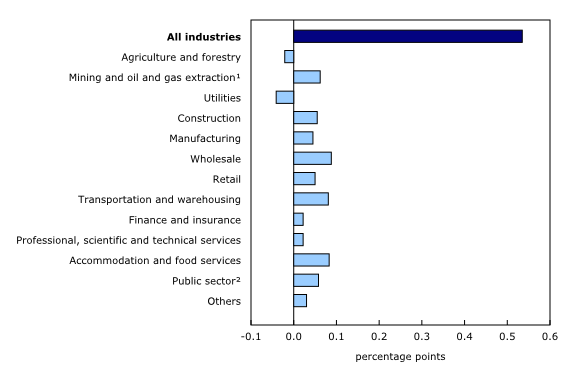
Consumer price index (CPI)
During the month of February, the CPI saw the biggest month over month deceleration since April 2020. Following January’s 5.9% increase, February’s CPI rose 5.2% year over year. Excluding food and energy, prices increased 4.8% year over year and 4.7% when excluding mortgage interest cost. Rising mortgage interest rates continue to apply serious upward pressure on the CPI, with the mortgage interest cost index rising 23.9% year-over-year, following a 21.2% increase in January. The Bank of Canada has now revised their inflation outlook to 3% by mid 2023. We expect the CPI to continue its declaration in March below 5%, those numbers will be available on April 18th.
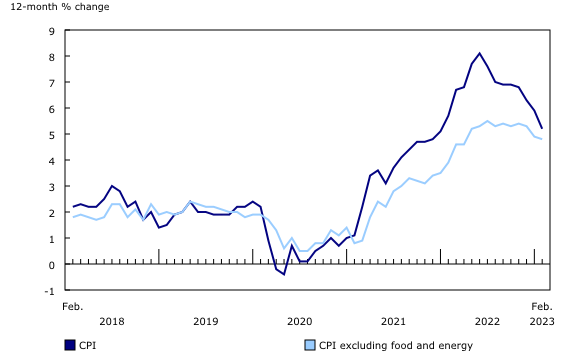
Unemployment remains low
Job vacancies increased 3.4% in January according to Stats Canada, a rebound, after trending down since June 2022. The job vacancy rate was 4.9% in January, with 1.2 unemployed persons for every job vacancy, essentially unchanged since August 2022. Prior to the pandemic, the unemployment-to-job vacancy ratio ranged from 1.9 to 3.1
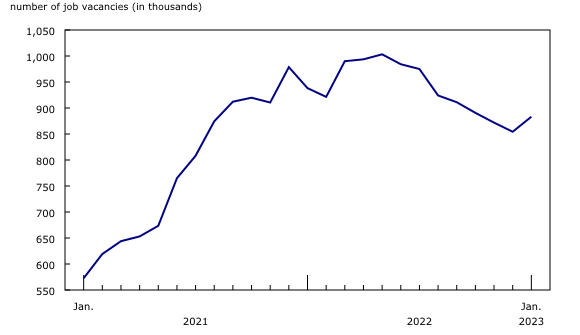
Canada added 22,000 new jobs in February, once again, surpassing expectations, however a substantial drop from the 150,000 new jobs added in January that left industry watchers nervous of what the Central bank might make of those numbers. The unemployment rate continues to hold at 5%, which should begin to increase in the coming months as high interest rates continue to slow the economy.
In January, employment numbers crushed expectations with Canada adding 150,000 new jobs, versus the expected 15,000. The unemployment rate remained unchanged at 5.0%, slightly higher than the record low of 4.9% reached in July. The bank of Canada wants to see the unemployment rate trend higher and closer to 6% as a sign of a loosening labour market, however as we’ve seen inflation continue to trend downwards, the unemployment rate has relatively remained unchanged.
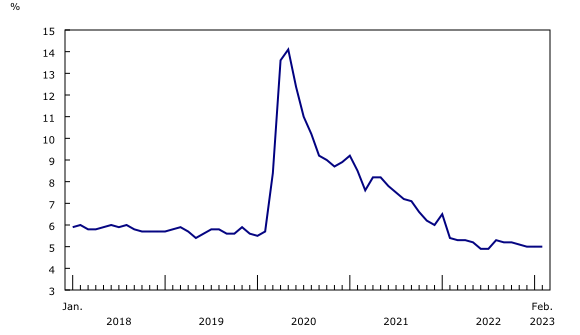
Wages are up but lag behind inflation
Average weekly earnings grew 5.4% year-over-year in February, up from January (4.5%). The central Bank anticipates weaker economic growth in the upcoming quarters to ease pressures in the labour market and moderate wage growth. Wage growth is an indicator that has been a sticking point for the Central Bank and slowing wages will further rally support for their decision to pause rate hikes as inflation has tampered significantly since mid 2022.
Canada’s population is growing faster than ever
Canada’s population grew by just over 1 million people in one year for the first time since 1957, this puts Canada’s estimated population at nearly 40 million with a 2.7% annual population growth. At this rate, it would only take 26 years for Canada’s population to double, in the short term, this will add further pressure on housing supply and driving the rental market upward.
According to Stats Canada, employment is rising fastest in group that includes non-permanent residents, up 13.3% (79,000) in January, this sector of the population accounted for 3.4% of total employment, up from 3.1% year over year. Adding further pressure on housing supply and driving the rental market upward.
Bonds respond to concerns in the banking sector
During the month of March, stress cracks in the foundation of international banks caused a rush into safer assets, which resulted in lower 5 year bond yields at home and abroad. March saw yields drop by approximately 90 basis points in the span of two weeks, the bond market is pricing in a higher risk of a recession.
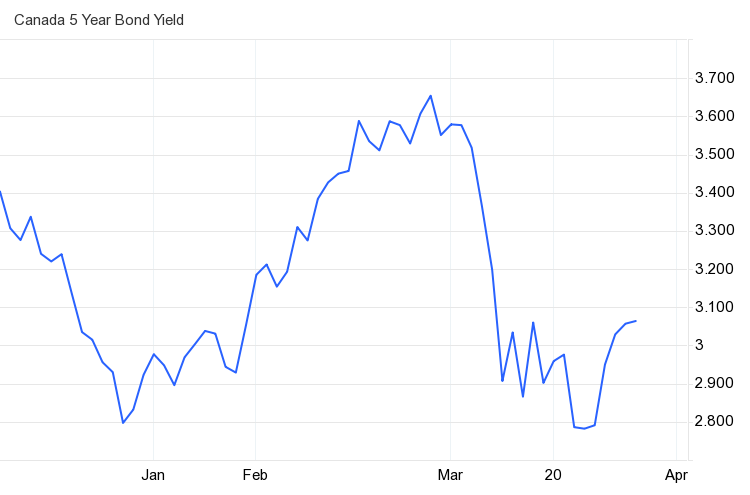
Is now the right time to buy a home?
With rate hikes paused and the housing market down across the board in cities, now might be the time to jump on the homeownership bandwagon if you’ve been waiting on the sidelines.
When interest rates eventually come down again it’s likely the increased demand will bring the housing market back to where it was pre 2022. If you go with a variable rate you could have the best of both worlds when rates come back down, or you could play it safe and go with a fixed rate mortgage.
Our current best 5-year fixed rates is 4.37% and 5-year variable rate of 5.65%.
For first-time home buyers, there are some great opportunities in a market dampened by negative sentiment and overall lack of competition, especially as new inventory begins to trickle in ahead of the spring market.
For homeowners who are coming up for renewal, continue to monitor our rate forecasts, it would be wise to see what rates Perch may be able to offer above and beyond your existing Lender, as they’re typically less aggressive on their rate offerings.
For homeowners who would like to see the benefit of switching lenders and breaking their mortgage early, Perch automatically calculates the net benefit once you input your existing property and mortgage details in your Perch portfolio.
 Ali
Ali






